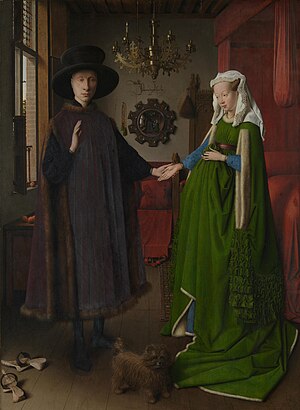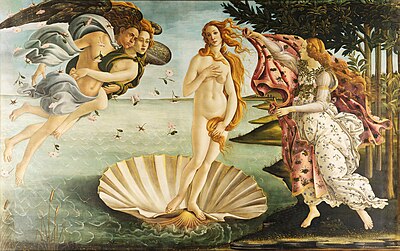The Renaissance
One
of the most amazing things in the history of our being is art. Art is open for
interpretation and there are so many ways to analyze a creator’s work. No
matter your perspective, anything can be said about the artwork. That fact
alone makes art so unique and so recognizable. In addition to this broad
description of art, it is also filled with a different time. Each focused on
specific elements and techniques. More specifically, the period known as, the
Renaissance is filled with artists that left marks on the way we perceive art
forever.
Jan
van Eyck left his footprint in the Renaissance by his unique style of artistry.
The painting in question is “Double Portrait of Giovanni Arnolfini and his
Wife.” There are many layers to this portrait. To start, the clothes stand out.
It seems they are being worn to symbolize wealth and elegance. From the hat to
the long dress, to the chandelier, it all showcases richness.
 |
| Jan van Eyck, Double Portrait of Giovanni Arnolfini and his wife, 1434 |
The man in the painting, Arnolfini, acquired his
wealth. He was part of a noble family, during this time inheritance was
becoming more common. His face is more recognizable than his wife. Her face
seems more generic and a mystery, while Giovani’s face is recognizable. The
message of the painting itself isn’t clear and it is still open to debate. For
the patronage aspect of the art piece, I would point to inheritance. During
Eyck’s time, Duke Phillip stated,” he could find no other painter equal to his
taste and abilities in art and science” (Stokstad,587). This was how people
felt about Eyck’s skill, very highly. Various themes can be drawn from this
work. Themes of wealth, marriage, loyalty are some to name a few. The dog in
the artwork helps symbolize a theme of loyalty. More symbols throughout the oil
painting consist of clothes, an abundance of wealth with items in the room such
as the chandelier, and a pregnant wife. Culturally speaking, inheritance was a
factor being depicted in the time of the Renaissance. This would tie in with
the economics of the time. Lastly, politically this was being more and more
acceptable. The times were shifting to a modern depiction from middle-aged
depictions.
Another special artist
during the enlightenment period was Tomaso di Ser Giovanni di Mone Cassai,
nicknamed and better known as Masaccio. One of his better productions of work
is his fresco called,” The Expulsion of Adam and Eve from Paradise.” This
fresco was beautifully executed. The message itself may not portray an elated
message, it still leaves behind the immense impact. To begin with, Adam and Eve
are universally known as God’s first human creations. In this specific artwork,
Masaccio has them filled with sorrow and maybe regret too. They are being
kicked out of paradise for not following rules and eating the forbidden fruit.
Something very interesting in this depiction is that Eve is covering up the
private regions of her body, which can relate to a theme of shame.
 |
| Masaccio, The Expulsion of Adam and Eve from Paradise, 1427 |
The structure of how Adam and Eve are seen. The detail
in their bodies, the realism in their movement, the way their muscles contract
with their movements is so human-like. “a single light source emphasizes their
physicality with modeled forms and cast shadows” (Stokstad, 624). The fresco has a source of light that casts a
shadow behind Adam and Eve, which adds more of a realistic feel to the
composition. The colors of the work are soothing and light. The major theme of
the work is shame. This points to the future of humans and their imperfections.
For his creations, Masaccio “integrated monumental and consistently scaled
figures into rational architectural and natural settings using their linear
perspective” (Stokstad,622). Many techniques were utilized for Masaccio to make
his art stand out for years to come. Masaccio was more appreciated by later
generations of painters, this speaks on the patronage system for him. To
continue, years later mythological characters came back and influenced the art
of the times.
The
work is known as,” Birth of Venus” served as a message for divine love in the
form of a nude Venus. Botticelli was the artist behind this masterpiece. Not
only does the painting show Venus, but there are people to each of her sides.
They are called Zephyrus and Chloris. She is also covering herself up.
 |
| Botticelli, Birth of Venus, 1484-1486 |
One
of the most acknowledged artists of all time was Michelangelo. He is arguably
most well-known for his marble sculpture of “David.” This was a creation that
was admired by everyone that witnessed it. David was a biblical hero. “David
was so admired that the city council instead placed it in the principal city
square” (Stokstad,659). There is so much behind this masterpiece. Michelangelo
has David in a concentrated form, this can symbolize the emotional power behind
the work.
 |
| Michelangelo, David, 1501-1504 |
He is holding his slingshot over his shoulder and the
rock is in the other hand. It seems the artwork is plotting out how to take
down the Goliath. Also, the message of doing what is right over the might you
may be against can be shown here too. Goliath outclasses David across the board
physically. Anyone who saw this sculpture came to love it because of the
overlaying message it provided. This creation brings a theme/sense of pride,
power, and resilience. All these paintings and artists were extraordinary for
what they brought to their period of art, and the future impact they left
behind.
In conclusion,
Jan van Eyck, Masaccio, Botticelli, and Michelangelo were artists that left
their artistic footprint for years to come. The Renaissance was truly an
inspiring period. Many styles of art were discovered through this time and
continue to serve as encouraging hallmarks in the art world.
Works
Cited
Stokstad, Marilyn, and Michael Watt Cothren. Art History. Sixth ed., II, Pearson, 2018.
No comments:
Post a Comment